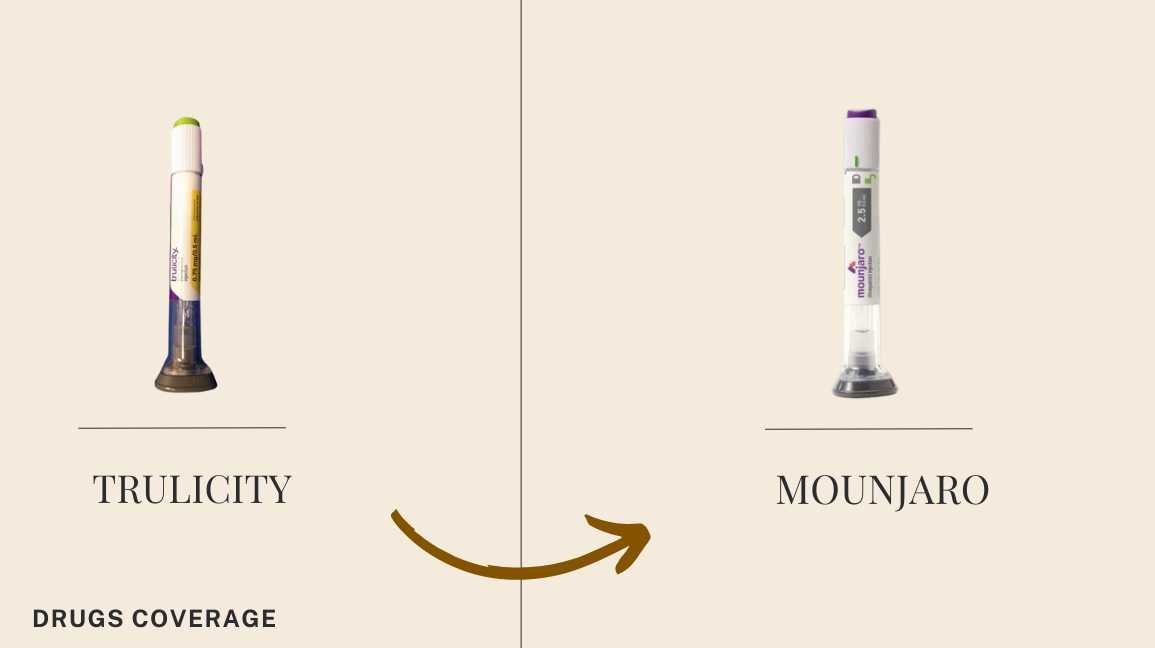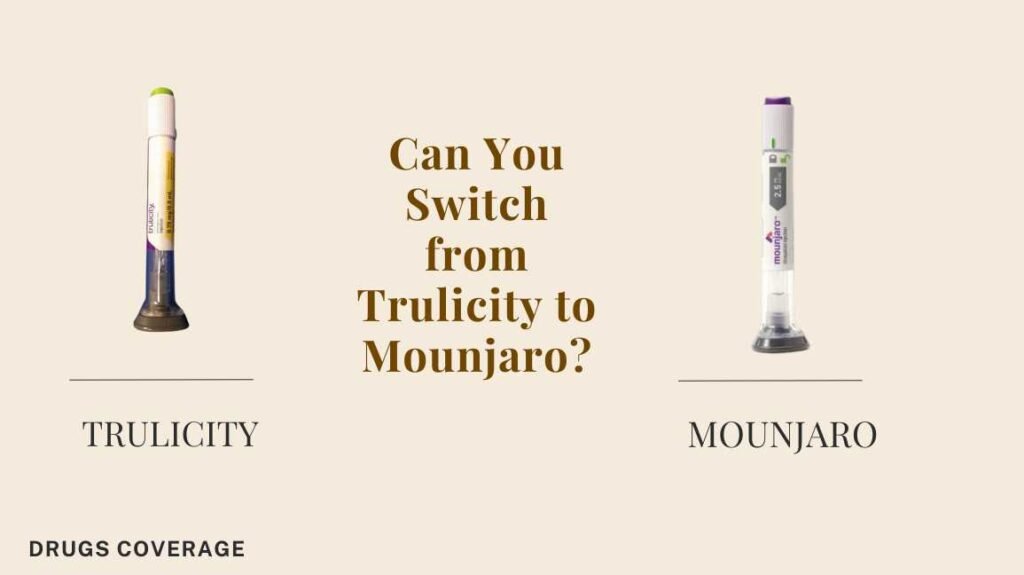
Switching from one medication to another, especially in the management of diabetes, is a decision that requires careful consideration and planning.
Trulicity and Mounjaro, both FDA-approved injectable medications, offer promising benefits for blood sugar control among individuals with type 2 diabetes. They work in different ways and might be better for different people depending on their health and what they need from their treatment.
In today’s article, we will discuss the key considerations for patients switching from Trulicity to Mounjaro. We’ll look at how they work, possible side effects, and what you might expect from the switch.
What is Trulicity?
Trulicity (dulaglutide) is a once-weekly injectable medication approved by the FDA for use in adults with type 2 diabetes. It belongs to a class of drugs known as GLP-1 receptor agonists.
These drugs mimic the action of the GLP-1 hormone, which plays a significant role in the regulation of blood sugar levels.
Trulicity works by turning on GLP-1 receptors in the body. This helps release insulin when sugar levels in the blood are high, slows down sugar-making in the liver, and also slows down food moving through the stomach. This can help control hunger and might help people lose weight.
Read more: Does Trulicity Cause Constipation?
Side Effects of Trulicity
Like all medications, Trulicity may cause side effects, some of which can be severe, while others may be mild and manageable. Here are some of the common and serious side effects associated with Trulicity:
Common Side Effects:
- Nausea and vomiting
- Diarrhea
- Abdominal pain
- Reduced appetite
- Indigestion
Serious Side Effects:
- Pancreatitis (inflammation of the pancreas)
- Kidney problems (including kidney failure)
- Severe allergic reactions
- Changes in vision
- Gallbladder problems (including gallstones)
If you experience any severe side effects or symptoms that concern you while taking Trulicity, it’s crucial to seek medical attention immediately.
Understanding Mounjaro
Mounjaro (tirzepatide) is the latest advancement in injectable medication for the treatment of type 2 diabetes, having received FDA approval in 2022. It represents a new class of diabetes treatment that targets both the GLP-1 receptor and the GIP receptor.
This dual mechanism of action is a groundbreaking approach that not only helps in controlling blood sugar levels but also supports weight loss more effectively than Trulicity.
Mounjaro functions by mimicking the actions of both the GLP-1 and GIP hormones, which play key roles in regulating blood sugar. By activating these receptors, it enhances insulin release in response to high blood sugar levels, decreases the liver’s sugar production, and slows the movement of food through the stomach.
Side Effects of Mounjaro
Similar to other medications, Mounjaro can cause side effects. These can range from mild to severe and may include:
Common Side Effects:
- Nausea
- Diarrhea
- Decreased appetite
- Vomiting
- Constipation
- Abdominal pain
Serious Side Effects:
- Thyroid tumors, including cancer
- Pancreatitis
- Kidney problems, including kidney failure
- Severe allergic reactions
- Low blood sugar (hypoglycemia), especially when taken with other diabetes medicines
Patients are advised to monitor for side effects and report any severe or unusual symptoms to their doctor immediately.
Related: Switching from Wegovy to Zepbound: A Patient’s Guide
Can You Switch from Trulicity to Mounjaro?

Yes, switching from Trulicity to Mounjaro is possible and may be beneficial for some patients. This is because Trulicity works by activating GLP-1 receptor agonists to control sugar levels, while Mounjaro has a dual function (GIP and GLP-1 receptor agonist) that controls both sugar levels and appetite.
However, the decision to switch from Trulicity to Mounjaro should be made in consultation with your doctor.
Criteria for Eligibility to Switch
To decide if someone can switch from Trulicity to Mounjaro, doctors look at a few important things. Here’s a simple overview of what they check:
- Treatment Goals: Patients with specific goals related to blood sugar control and weight loss, which might be better achieved with Mounjaro’s dual mechanism.
- Current Health Status: Overall health and presence of any conditions that might interact with Mounjaro differently than with Trulicity.
- Response to Trulicity: Effectiveness of Trulicity in managing diabetes symptoms and any side effects experienced.
- Medical History: A history of thyroid disease, pancreatitis, kidney problems, or severe gastrointestinal disease may affect eligibility.
- Other Medications: Current medications for diabetes or other conditions that could interact with Mounjaro.
- Financial Considerations: Cost and insurance coverage differences between Trulicity and Mounjaro.
Also Read: Does BCBS Mounjaro for Weight Loss?
Making the Switch: A Step-by-Step Guide
Switching from Trulicity to Mounjaro should be approached with care, ensuring a smooth transition and effective management of type 2 diabetes. Below is a step-by-step guide designed to facilitate this process:
- Talk to Your Doctor: Start by setting up a time to chat with your doctor about why you’re thinking of changing from Trulicity. Talk about how it’s working for you, any side effects, and what you hope to achieve with your treatment.
- Evaluate Your Health Status: Your doctor will review your medical history, current health status, and any potential risk factors to ensure Mounjaro is a suitable option for you or not.
- Insurance and Cost Considerations: Investigate the cost of Mounjaro and whether your insurance plan covers it. Some patients may need to apply for manufacturer savings programs or consider alternative financial assistance options.
- Plan the Switch: f your doctor agrees, they’ll tell you how to switch from Trulicity to Mounjaro. This will include when to stop taking Trulicity and when to start Mounjaro so their effects don’t mix or leave a break in your treatment.
- Be Patient and Communicate: Transitioning between medications can require adjustments, and it might take time to notice the full benefits of Mounjaro. Communicate any concerns or side effects to your provider promptly.
By following these simple steps, patients can safely switch from Trulicity to Mounjaro, making sure it fits their health goals with a professional’s help.
RELATED: Mounjaro Pen Not Working? Here are 5 Steps To Take If It Happens
What challenges might you face when switching?
Switching from one medication to another, especially in the treatment of chronic conditions like type 2 diabetes, poses unique challenges that require careful consideration and management. Some potential hurdles include:
- Adaptation to New Side Effects: Even though Mounjaro might be more effective in some aspects, adapting to its side effects compared to those experienced with Trulicity can be challenging for some people.
- Monitoring for Safety: Close monitoring is necessary after the switch to ensure that Mounjaro effectively manages blood sugar levels without causing unforeseen health issues. This may involve frequent blood tests and doctor appointments, at least in the initial months following the change.
- Effectiveness: Mounjaro might work better for some, but not for everyone. It could be less good at managing your blood sugar, or you might need time to find the best dose for you. If Mounjaro doesn’t work out, your doctor might suggest going back to Trulicity or trying a different medication altogether.
- Psychological Adjustment: Patients may experience anxiety or uncertainty about changing their medication regimen, especially if they have been stabilized on Trulicity for a long time.
Conclusion
In conclusion, switching from Trulicity to Mounjaro is a decision that has the potential to improve the management of type 2 diabetes for many. With proper evaluation of health status, planning, and close monitoring, this switch can be a successful step toward achieving treatment goals.
However, it is essential to work closely with your doctor throughout the process to ensure a smooth and safe transition. So, if you’re considering making the switch from Trulicity to Mounjaro, talk to your healthcare provider and explore whether it’s the right decision for you.
FAQ
Can anyone with type 2 diabetes switch from Trulicity to Mounjaro?
Not everyone with type 2 diabetes will be a suitable candidate for switching from Trulicity to Mounjaro. The decision to switch depends on individual health factors, treatment goals, and how well Trulicity is currently managing their diabetes.
How long does it take to notice changes after switching to Mounjaro?
The time it takes to notice changes after switching to Mounjaro can vary from person to person. You might feel less hungry soon, possibly in the first few weeks. Weight loss could start in about four weeks for some, but it usually takes longer to see the full weight loss effects. Big changes might take up to 18 months. And for blood sugar, it starts working immediately, but it might take several weeks to really see the difference. Your physician will probably keep a close eye on your blood sugar levels during this period and adjust your dosage as necessary.
Will I lose weight by switching to Mounjaro?
Many patients do experience weight loss after switching to Mounjaro due to its effect on appetite regulation and blood sugar control. However, the amount of weight loss can vary depending on some factors such as diet, exercise, and individual health conditions.